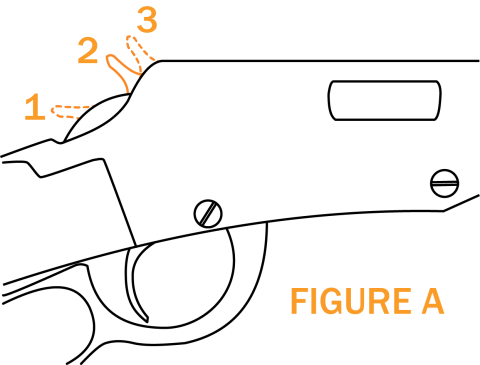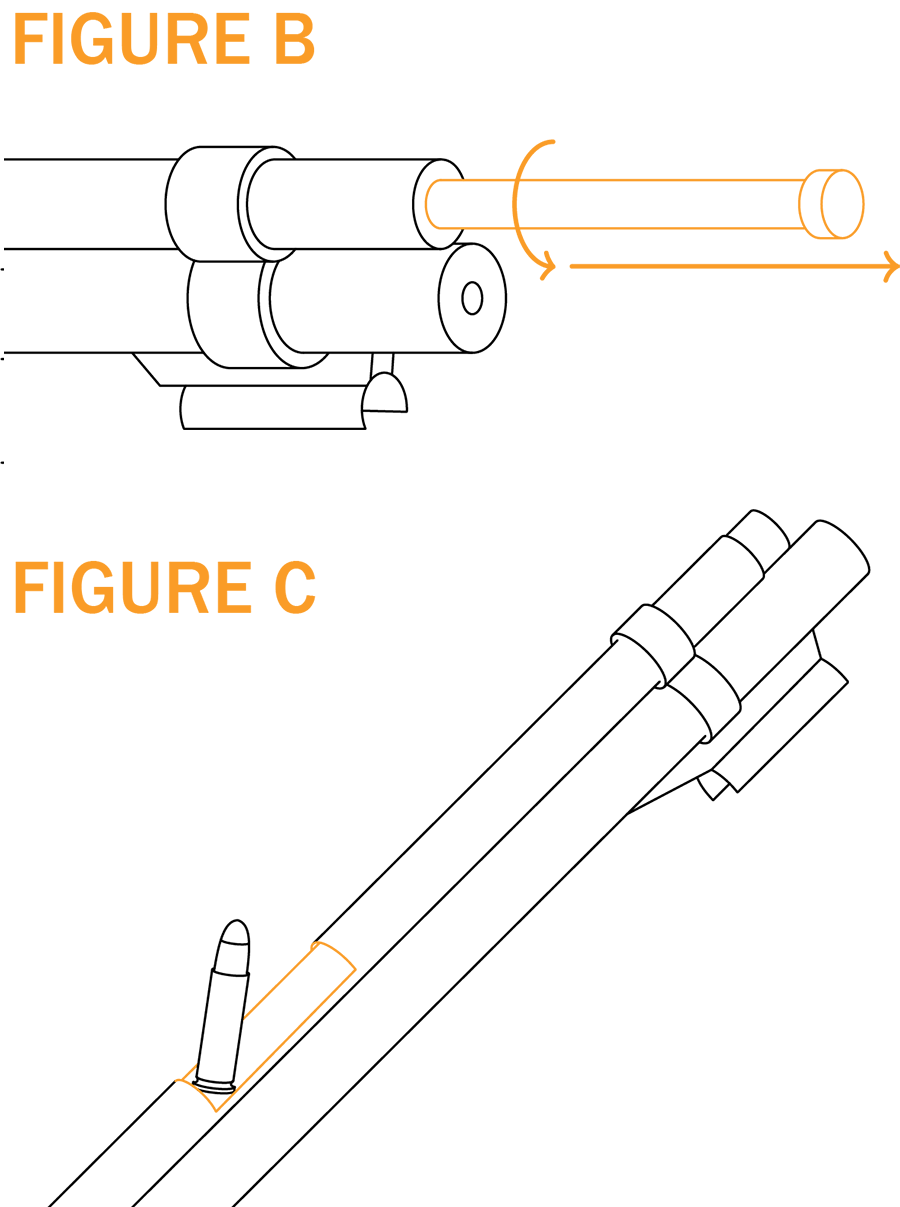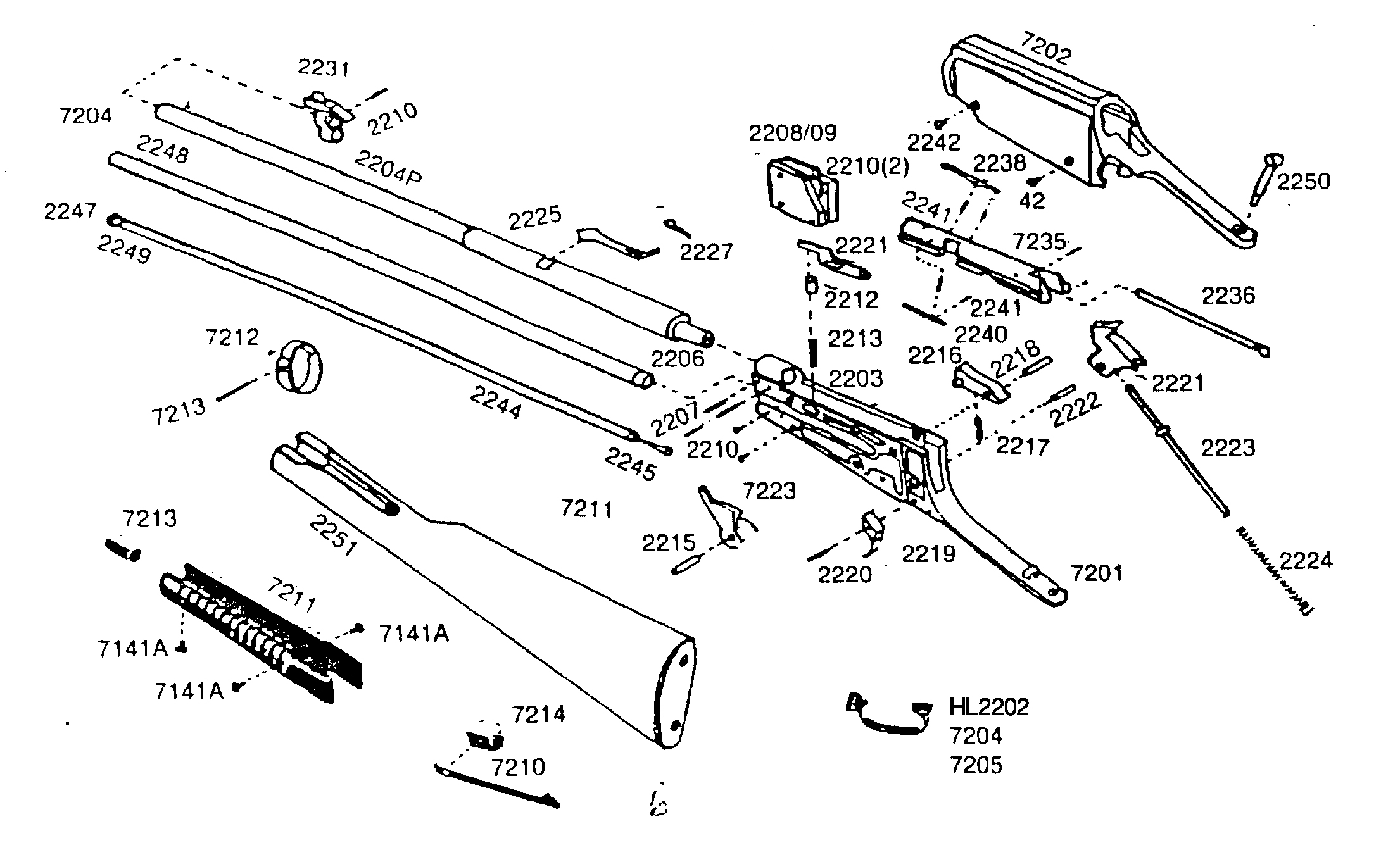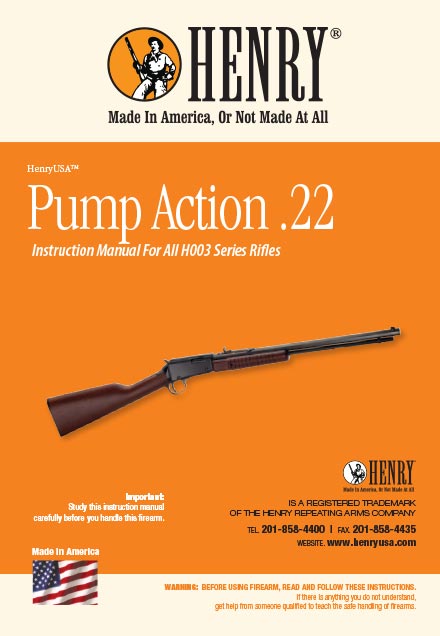The Henry Guarantee

We are confident that you’ll enjoy and be proud to own any of our Henry firearms, well known for their reliability, accuracy, handsome looks and smooth action.
Our goal has and always will be to manufacture a line of classic, well-crafted firearms that every enthusiast would find readily affordable.
We take great pride in manufacturing our shotguns in the United States, hence our corporate motto “Made in America, or Not Made at All”.
Thank you very much for spending your hard earned money to purchase a Henry. I certainly appreciate it and welcome you to the Henry family. As an owner of a Henry, you are backed by our lifetime warranty and my personal guarantee for 100% satisfaction. I will do what it takes to make certain you are happy with your purchase.
Sincerely,
Anthony Imperato
Henry Repeating Arms
Telephone: 201.858.4400
Simple Limited Lifetime Warranty
It is our promise to you that as long as you own your Henry firearm, it will be free from defects in material and workmanship from the manufacturer. If you have a problem with your Henry firearm, we will fix it at no charge to you. Henry Repeating Arms shall repair, send replacement parts or replace the firearm with a valid warranty claim. If a complete replacement is necessary, the original firearm will not be returned. Henry RAC will provide repairs or replacement at no charge, but will not offer cash, credit, or refund.
WE RESERVE THE RIGHT TO REFUSE SERVICE ON FIREARMS THAT HAVE BEEN ALTERED, ADDED TO, OR SUBSTANTIALLY CHANGED.
Removal of metal from the barrel, or modifications of the firing mechanism and/or operating parts, may lead to a refusal of service on such firearms. There will be a charge for parts and labor to return the firearm to original specifications.
DO NOT, UNDER ANY CIRCUMSTANCES, ALTER THE TRIGGER, “SAFETY” OR OTHER PARTS OF FIRING MECHANISM OF THIS OR ANY OTHER FIREARM. FAILURE TO OBEY THIS WARNING MAY RESULT IN INJURY OR DEATH.
NOTICE: Henry RAC shall not be responsible for injury, death, or damage to property resulting from either intentional or accidental discharge of this firearm, or from its function when used for purposes or subjected to treatment for which it is not designed.
Whether or not you are experienced in the safe handling of firearms, we urge you to read this entire instruction manual carefully. You must follow the safety instructions for your safety and the safety of others. Should you have any questions concerning the instructions in this manual, please call us at 201-858-4400.
WARNING: If you have little or no experience in the safe handling and operation of a firearm, we strongly urge you to take a firearms safety course from an NRA Certified Instructor or someone with equivalent qualifications before using this or any other firearm. You can contact the NRA Firearms Education and Safety Division at 703-267-1470 for the name of an instructor in your area, or contact your firearms dealer, law enforcement agency or local sportsman’s club for training.
General Gun Safety Handling
Apply the following safety rules in every situation, with any kind of firearm:
ALWAYS TREAT EVERY FIREARM AS IF IT IS LOADED AND WILL FIRE. Do not take anyone’s word that the firearm is unloaded – always check for yourself. Never pass your firearm to another person until the cylinder or action is open and you visually check that it is unloaded. Keep your firearm unloaded and safely stored when not in use.
ALWAYS BE SURE OF YOUR TARGET AND WHAT IS BEYOND. A bullet could travel through or past your target for up to 1½ miles. Always be sure your backstop is adequate to stop and contain bullets before beginning target practice so that you do not hit anything outside the range shooting area. If in doubt, don’t shoot! Do not fire randomly into the sky.
NEVER SHOOT ACROSS A HIGHWAY OR ANOTHER ROADWAY.
ALWAYS POINT YOUR FIREARM IN A SAFE DIRECTION. NEVER point a firearm at anyone or anything you do not intend to shoot whether or not it is loaded. This is particularly important when loading, unloading, or field stripping the firearm. ALWAYS control the direction of the firearm; if it fires accidentally, injury, death, or damage to property can be avoided.
NEVER PLACE YOUR FINGER INSIDE THE TRIGGER GUARD OR ON THE TRIGGER UNLESS YOU INTEND TO FIRE. You should also take care to ensure that other objects do not touch the trigger.
NEVER USE ALCOHOL OR DRUGS BEFORE OR WHILE SHOOTING. Your vision, motor skills and judgment could be dangerously impaired, making your gun handling unsafe to you and to others. Further, do not use your firearm if you are on any medication which impairs, even slightly, your mental or physical ability.
ALWAYS SEEK A DOCTOR’S ADVICE IF YOU ARE TAKING MEDICATION. Be sure you are fit to shoot and handle your firearm safely.
NEVER SHOOT AT A HARD SURFACE SUCH AS A ROCK OR A LIQUID SURFACE SUCH AS WATER. A bullet may ricochet and travel in any direction to strike you or an object you cannot see, causing injury, death or damage to property.
NEVER DISCHARGE A FIREARM NEAR FLAMMABLE MATERIAL. Flame and sparks erupt from the firearm when discharged. They could start a fire or cause flammable liquids to explode.
ALWAYS BE AWARE OF POSSIBLE RISK FROM DROPPING YOUR FIREARM. Some parts of the mechanism could be damaged. You may not see the damage, but it could be severe. The firearm may discharge and cause injury, death, or damage to property. If your firearm has been dropped, have it examined by a competent gunsmith before using it again.
ALWAYS KEEP AND CARRY YOUR FIREARM EMPTY WITH THE HAMMER IN THE “SAFE” POSITION except when you intend to shoot, so that your firearm cannot be fired when you do not intend to fire it.
NEVER CROSS OBSTACLES SUCH AS FENCES OR STREAMS WITH A LOADED FIREARM. Always make certain your firearm is unloaded before crossing a fence, climbing a tree, jumping a ditch or approaching other obstacles.
NEVER TRANSPORT A LOADED FIREARM. Keep all firearms unloaded during transport, even when stored in a holster, gun case, scabbard or other container.
NEVER WALK, CLIMB, OR FOLLOW A COMPANION WITH YOUR FIREARM COCKED AND READY TO FIRE. When hunting, hold your firearm so that you can always control the direction of the muzzle.
NEVER LEAVE A LOADED FIREARM UNATTENDED. Someone, especially a child, may fire it and cause injury, death, or damage to property.
ALWAYS INSTRUCT CHILDREN AND NON SHOOTERS TO RESPECT FIREARMS. If you teach your children to shoot or get them trained by a qualified instructor, be certain they know how to use the firearm properly and always supervise them closely. Always stress safety so that your children or others will not fire a rifle when or where it is unsafe to do so.
Specifications
.22 Mag
.22 Mag – 12 rounds
/Type
.22 Mag – 39″
Ammunition Selection
Henry RAC Firearms are designed to function with a variety of brands and types of factory-manufactured ammunition in the appropriate caliber but not all ammunition produces the same result. Henry RAC recommends that after you read and understand this manual, you go to the range and fire different ammunition which is appropriate to the caliber of your firearm. Once you find the ammunition which functions best, keep using it. Especially when cutting-edge reliability and accuracy are vital to you. When sighting your rifle, shoot a group to determine point of impact on the target. Then make incremental adjustments to center the point of impact on the target bullseye.
WARNING: Discharging firearms in poorly ventilated areas, cleaning firearms or handling ammunition may result in exposure to lead, a substance known to cause birth defects, reproductive harm and other serious physical injury. Have adequate ventilation at all times. Wash hands thoroughly after exposure.
CAUTION: Always keep the muzzle pointed in a safe direction.
Extremely Important: You must become thoroughly familiar with knowing how to place the hammer into the safety position and the trigger is immovable. You must practice this procedure several times with an unloaded rifle to become thoroughly familiar with it. You must become familiar with the following procedure. Do not attempt to operate this firearm unless you know how to place the hammer in the safety position.
NOTE: Whenever you need to unlock the forearm in order to pull it back and open the action, pull back on the grooved release button at the right front of the trigger guard. This will enable you to pull the forearm back and open the action.
Range and Shooting Cautions
ALWAYS DESIGNATE A KNOWLEDGEABLE AND RESPONSIBLE PERSON TO BE IN CHARGE TO MAINTAIN SAFETY CONTROL WHEN A GROUP IS FIRING ON A RANGE. Obey their commands so that discipline is maintained to reduce the possibility of accidents.
ALWAYS CARRY YOUR FIREARM EMPTY WITH THE ACTION OPEN WHILE ON A RANGE until preparing to fire and keep it pointing towards the backstop when loading, firing, and unloading to eliminate the risk of injury, death or damage to property.
ALWAYS KEEP THE HAMMER IN THE uncocked POSITION UNTIL YOU ARE READY TO FIRE. This will minimize the risk of an accidental discharge.
ALWAYS WEAR EYE AND EAR PROTECTION SPECIFIED FOR USE WITH FIREARMS. Flying particles could damage eyes and cause blindness. Without ear protection, the noise of even one shot from your rifle and from other guns close to you could leave a “ringing” in the ears for some time after firing and the cumulative long term effect could be permanent hearing loss. Make sure others in the vicinity of where you are shooting are doing so as well.
ALWAYS KEEP CLEAR AND KEEP OTHERS CLEAR OF THE EJECTION PORT. Spent shells are ejected with enough force to cause injury. The ejection port must also be unobstructed by your hand to insure safe ejection of spent rounds. Never place fingers in ejection port – they could be burned by hot metal or injured by the bolt moving forward.
NEVER PUT YOUR FINGER INSIDE THE TRIGGER GUARD UNTIL YOU ARE AIMING AT A TARGET AND READY TO SHOOT. This will prevent you from firing the firearm when it is pointing in an unsafe direction.
NEVER JOKE AROUND OR ENGAGE IN “HORSEPLAY” WHILE HANDLING YOUR FIREARM. Doing so could cause an accidental discharge.
Operating Instructions
1/4 Cock Safety
 HOW TO PLACE THE HAMMER IN THE SAFETY POSITION
HOW TO PLACE THE HAMMER IN THE SAFETY POSITION
There are two ways to set the hammer into the Safety position. Always keep the gun pointed in a safe direction. With the hammer in the fired (down) position (#3 Figure A), cock the hammer back slightly, about a 1/16th to a 1/8th of an inch, until you feel and hear the hammer click into the Safety position (#2 Figure A). The hammer and trigger will now be locked into the Safety position and, if you pull the trigger to fire, the trigger should not move and the hammer should not fall.
The second way to set the safety is to cock the hammer all the way by pulling the forearm back, thus opening the action and pushing the hammer back into the fully-cocked position (#1 Figure A). Then push the forearm fully forward closing the action. Warning: This causes a round to be loaded into the chamber and the gun is now ready to fire! Now firmly hold the hammer back with your thumb. While holding the hammer, apply just enough pressure on the trigger to release the hammer from the full cock position. Remove your finger from the trigger very quickly and slowly lower the hammer into the Safety position. The hammer will now be locked into the Safety position and if you pull the trigger to fire the hammer should not fall. The trick to setting the Safety this way is to remove your finger very quickly from the trigger when dropping the hammer into the Safety position.
Warning: When the chamber is loaded, never place the hammer in the fired (down) position (#3 Figure A).
Warning: The safety is designed to secure the hammer, holding it from contacting the firing pin. However, this mechanism will not necessarily prevent the accidental discharge of this firearm as a result of jarring, abuse or mishandling.
How to Load
Prior to loading your rifle, make certain that the rifle is not already loaded. Point the muzzle in a safe direction and pull the forearm back to open the action. If a cartridge ejects, proceed with directions on how to unload the magazine tube and empty and clear the chamber. We recommend that you always load a completely unloaded firearm and clear the firearm of any cartridges prior to loading.
Assuming that you are now handling an unloaded firearm, make certain that the barrel, receiver and chamber are free from any grease, oil debris or any other obstruction. Make certain that the ammunition you are about to use is .22 rimfire caliber. Make certain that you are using name-brand, top quality ammunition. With your new Henry Pump Action .22, you can use .22 Long Rifle, .22 Long or .22 Short. The capacity for .22 Long Rifle is 15 rounds, .22 Long 15-17 rounds, and for .22 Short it is 21 rounds. WARNING: You cannot use .22 Magnum rounds in a .22LR or vice versa.
To load the magazine tube, first place the hammer in the Safety Position. To place the hammer into the Safety Position, first point the muzzle in a safe direction. Next, cock the hammer by pulling the forearm back then pushing it forward. Then, firmly hold the hammer back with your thumb.

IMPORTANT: Now, while holding the hammer back with your thumb, apply just a little bit of pressure on the trigger to release the hammer from the full-cock position (Figure A-1) and immediately and simultaneously remove your finger from the trigger. Slowly and carefully allow the hammer to lower into the Safety position. (Figure A-2)
You are now ready to load.
Twist the inner magazine tube by disengaging the magazine button (Figure B) and pulling the tube out until the orange colored follower is visible through and clears the loading port in the outer magazine tube.
With the muzzle pointed upward, insert the rimmed end of the cartridges into the magazine (Figure C) and allow them to slide down towards the action. Do not exceed the capacity of the magazine. Next, push the inner magazine tube back down into position and lock into place. Please be careful when pushing the inner magazine tube in, as it is under spring tension.
The rifle is now ready for operation.
How to Operate
The rifle chamber can now be loaded by pulling the forearm back completely and then pushing it back to a closed position. Important: The rifle is now set to fire. The hammer has been moved from the Safety position to the Full-Cock position. Always place the hammer back into the Safety position until you are ready to fire. When ready to fire, take the hammer from the Safety position. Remove your finger off the trigger, firmly grip the hammer with your thumb and draw the hammer back into Full-Cock position.
You are now ready to fire. Take aim, make certain that you are firing in a safe environment, that neither you nor any other person is in danger and, when on target, squeeze the trigger.
To chamber the next round, pull the forearm back completely and push it back to the closed position. This process will eject the fired cartridge case from the camber and transfer a new cartridge from the magazine to the chamber. Important: This leaves the hammer in a full-cocked, ready to fire position. If you are not ready to fire, go into the Safety Position.
When through firing, always place the hammer in the Safety Position. Always unload your gun when you have finished shooting, making certain that the magazine and chamber are empty, before putting your gun away.
How to Unload The Magazine and Chamber
To unload the magazine and chamber of a loaded Henry Pump Action Rifle, make sure that the hammer is resting in the Safety position. With the rifle pointing upward or in a safe direction, completely withdraw the inner magazine tube from the gun. Tip the rifle downward, allowing the cartridges to slide out into a suitable container. Replace the inner magazine tube. Very carefully, open the action to eject the chamber round, if any. Cycle the action multiple times to insure and to be positive that no live rounds remain in the chamber. It is best to do a final visual inspection of the chamber area.
Sights and Sight Adjustments
Before making any sight adjustments, check the tubular magazine and the chamber to make sure your gun is completely unloaded. Place the hammer in the safe position.
When sighting your rifle, shoot a group to determine point of impact on the target. Then make incremental adjustments to center the point of impact on the target bullseye.
ELEVATION: Up or down adjustments
To shoot higher, move rear sight up. To shoot lower, move rear sight down. There is a secondary adjustment in the white diamond insert of the rear sight. Loosen the screw to the right of the white diamond, raise or lower as needed to correct elevation, then re-tighten the screw.
To adjust for elevation, use your fingertips to gently lift the rear sight notch blade up just enough to free the notched elevator slide so that it can be carefully moved forward or rearward. Move the notched elevator slide forward to shoot lower or rearward to shoot higher.
WINDAGE: Horizontal Adjustment
If you are shooting to the right of the target, move the rear sight to the left to correct the point of impact. If you are shooting to the left, move the rear sight to the right to correct the point of impact.
The base of the rear sight is dove-tailed into a groove on the barrel. To make horizontal adjustments, the entire dove-tailed base must be moved right or left in its’ slot on the barrel. Current models will have a screw on the front of the rear sight assembly. This screw must first be loosened, prior to attempting adjustment. To do this, carefully use a softwood, fiber or plastic dowel, slightly pointed but having a flat point appropriate in size to properly engage the left or right end of the sight base where it slides in the groove on the barrel. Gently tap the dowel with a light hammer and be very careful not to mar or damage the barrel or sight base. To help you determine how far you have moved the sight, right or left, a soft pencil can be used. The front edge of the rear sight base comes to a point where it rests on the barrel. At the point of the sight base, lightly make a small mark with the pencil and carry it straight down to make a small adjoining mark on the barrel. This will show you how far to the right or left you have moved the sight base. When your adjustments are completed, the marks can easily be wiped off with a lightly-oiled, soft cloth. It should also be remembered that if you change the brand or type of .22 ammunition you are using, sighting adjustments are a normal expectation.
Malfunction and Troubleshooting
NEVER USE YOUR FIREARM IF IT FAILS TO FUNCTION PROPERLY, AND NEVER FORCE A JAMMED ACTION. Forcing the action could make the round explode, causing serious injury, possible death, or severe damage to your firearm or other property.
FAILURE TO FIRE. A misfire occurs when the firing pin strikes the primer and it does not fire. IF THE FIREARM FAILS TO FIRE DO NOT PUT IT DOWN OR OPEN THE ACTION. ALWAYS HOLD THE FIREARM, KEEPING IT POINTED IN A SAFE DIRECTION AND WAIT 30 SECONDS. IF A HANGFIRE (SLOW IGNITION) HAS OCCURRED, THE ROUND WILL FIRE WITHIN 30 SECONDS.
If the round does not fire, remove the ammunition, eject the round and examine the shell. If the firing pin indent on the primer is light or non-existent, have the firearm examined by a competent gunsmith before firing again. If the firing pin indent on the primer appears normal (in comparison with similar previously fired rounds) assume you have faulty ammunition. Segregate the misfired round from other live ammunition and empty cases, reload, and carry on firing.
FAILURE TO EXTRACT (FTE). This is when the firearm discharges the round and fails to extract the spent round from the chamber. This could happen because of a bad extractor or bad/damaged casings.
FAILURE TO FEED (FTF). This is simply when the firearm fails to feed another round into the chamber. Put the lever in the open position and clear the ejection port.
Note: The ejection port should face the ground; this will allow the round to easily fall out (gravity is your friend here). This will work for both left and right handed shooters.
Cleaning, Storage and Maintenance
Cleaning Safety Precautions
WARNING: BEFORE PERFORMING CLEANING PROCEDURES, MAKE SURE THE HAMMER IS IN THE FIRED-DOWN POSITION, WHICH ALLOWS YOUR SAFETY TO FUNCTION AS DESIGNED. OPEN THE ACTION AND MAKE CERTAIN YOUR FIREARM IS COMPLETELY UNLOADED. KEEP THE MUZZLE POINTED IN A SAFE DIRECTION. FAILURE TO FOLLOW THESE WARNINGS COULD RESULT IN SERIOUS INJURY OR DEATH.
KEEP ALL AMMUNITION AWAY FROM THE CLEANING AREA. NEVER TEST THE MECHANICAL FUNCTION OF YOUR RIFLE WITH LIVE AMMUNITION. FAILURE TO FOLLOW THESE WARNINGS COULD RESULT IN SERIOUS INJURY OR DEATH.
NOTICE! It is very important that the bore of your rifle be cleaned thoroughly and promptly after shooting. Do not leave discharged (empty) cases in the chambers for any length of time, as the chemical composition of many cartridges contain moisture which can “sweat” out of the shell and onto the chambers’ surfaces, and possibly cause corrosion and rust.
How to Clean
Make certain to clean your rifle after firing. We suggest that you purchase a current, name brand, top quality rifle cleaning kit. Make sure that the rifle is empty, and open the action. Using a the cleaning rod with a lightly-oiled patch, run the rod from the muzzle end of the barrel down toward the breech area, cleaning the bore and chamber. Use a cleaning swab to remove all debris from the chamber area as well as the face of the bolt. It is important to make certain that there is no debris in the chamber area or on the face of the bolt. The balance of the bolt assembly and action are maintenance free.
IMPORTANT – PLEASE NOTE THAT THE RIFLE DOES NOT COME APART FOR CLEANING AND THAT THERE IS NO REASON TO TAKE IT APART FOR CLEANING.
WARNING! DO NOT USE ABRASIVES SUCH AS GUN SCRUBBER. USE ONLY MILD SOLVENTS OR GUN OILS SUCH AS BREAKFREE, KLEENBORE FORMULA 3, OUTER SOLVENTS OR HOPPES #10.
Maintenance
Be sure that your gun is unloaded before attempting to clean.
The gun owner is responsible for periodic inspection and proper maintenance by a qualified gunsmith to ensure that this firearm remains in proper adjustment and that worn parts are replaced.
Remember: Rust is neglect – Make sure all exposed metal surfaces are coated with a film of oil. After being subjected to damp weather, thoroughly wipe the bore and wipe off the exposed metal surfaces. Then apply a new film of oil to the blued metal surfaces. If exposed to a soaking rain, snow or salt spray a more thorough cleaning and oiling may be necessary, requiring removal of the trigger guard and breech bolt assemblies.
Between seasons, apply a coat of quality gun oil to the bore and blued-metal parts and store in a dry place. Do not plug the barrel or store in a case made of fabric or material which will absorb the lubricant from the gun or retain humidity.
Make certain to thoroughly clean your firearm when finished firing. We suggest that you purchase a name brand, top quality rifle cleaning kit.
Replacement parts are available through the Henry Repeating Arms Company Parts Department. In the following pages you will find a parts diagram and price list. Please be sure to include the catalog number and Serial number of your gun when ordering parts.
Storage Safety and Precautions
NEVER LOCK A LOADED FIREARM AND NEVER LOAD A LOCKED FIREARM!
ALWAYS CHECK TO MAKE SURE YOUR FIREARM IS NOT LOADED BEFORE CLEANING, STORING, TRANSPORTING IT, LAYING IT DOWN, OR HANDING IT TO ANOTHER PERSON so that it cannot be fired when it is unsafe to do so.
ALWAYS KEEP AND STORE YOUR FIREARM AND AMMUNITION IN SEPARATE, LOCKED LOCATIONS, OUT OF REACH AND SIGHT OF CHILDREN AND UNTRAINED PERSONS. Safe and secure storage of your firearm and ammunition are your responsibility.
NEVER LEAVE THE KEY TO THE LOCK FOR YOUR FIREARM WITH THE STORED FIREARM!
NEVER ASSUME THAT A “HIDING” PLACE IS A SECURE STORAGE METHOD. Others may be aware of your storage location or come upon it by chance. It is your personal responsibility to use common sense when storing your firearm and ammunition and to always make sure they are not accessible to children or other unauthorized persons.
NOTE: Do not store your firearm in an air-tight container, and do not seal or attempt to seal the barrel to exclude dust, as the internal steel surface is more likely to rust or corrode by doing this.
BEWARE OF BARREL OBSTRUCTIONS. Be sure the barrel is clear of obstructions before shooting. Mud, water, snow or other objects may inadvertently lodge in the barrel bore. A small obstruction can cause a dangerous increase in pressure and may damage your firearm and cause injury to yourself and others.
BEFORE CHECKING FOR A BARREL OBSTRUCTION, BE CERTAIN YOUR FIREARM IS COMPLETELY UNLOADED. After assuring yourself that the firearm is completely unloaded, open the action and look through the barrel to be sure it is clear of obstructions. If an obstruction is seen, no matter how small it may be, clean the bore with a cleaning cord or a patch as described in the CLEANING section of this owner’s manual.
BE SURE ALL ACCESSORIES, SUCH AS SLINGS, SCOPES AND OTHER ACCESSORIES ARE COMPATIBLE WITH YOUR PARTICULAR FIREARM AND THAT THE ACCESSORIES DO NOT INTERFERE WITH ITS SAFE OPERATION.
It is your responsibility to understand and follow all of the instructions in the safety manual that accompanied your firearm, as well as those which may be supplied with your ammunition and any accessory.
NEVER DISASSEMBLE YOUR FIREARM BEYOND THE FIELD STRIPPING PROCEDURE OUTLINED IN THIS MANUAL. Improper disassembly or reassembly of your firearm may be dangerous and can lead to serious injury or death.
NEVER MANIPULATE, ADJUST OR CHANGE ANY OF THE INTERNAL COMPONENTS OF YOUR FIREARM UNLESS SPECIFICALLY INSTRUCTED TO DO SO IN THIS MANUAL. Improper manipulation of any other internal component may affect the safety and reliability of your firearm and may cause serious injury or death.
NEVER ALLOW ANY ALTERATION OR REPLACEMENT OF PARTS IN YOUR FIREARM UNLESS PERFORMED BY A QUALIFIED GUNSMITH USING AUTHORIZED PARTS. If you do otherwise, improper functioning of your firearm may occur and serious injury or death and damage to property may result.
Parts
An illustration and list of part names are included in this manual. Please note that not all parts are available for sale. Those parts which are available should be installed by a licensed gunsmith. When ordering parts, please give part name and part number.
Important: If you make unauthorized adjustments or use unauthorized parts, Henry Repeating Arms Company will not assume responsibility for the proper functioning of the shotgun.
This gun is manufactured to perform properly with the original parts as designed. It is your duty to make sure any parts you buy are installed correctly and that neither replacements nor originals are altered or changed. This is why we say take it to a licensed gunsmith station. Your gun is a complex tool with many parts that must relate correctly to other parts. Putting a gun together wrong or with modified parts can result in a damaged gun, danger, and injury or death to you and others through malfunction. Always let a qualified gunsmith work on your gun and check any work you think was not performed by a gunsmith.
List of Parts

Servicing and Repair
If you believe that your Henry firearm requires repair or adjustment, we suggest that you first contact our Customer Service by visiting the “Contact Us” page on our website, or by phone at 201.858.4400. It may be a problem that we can resolve by phone or by sending a replacement part. For international customers please visit the “Contact Us” page on our website for instructions.
In the unlikely event that your firearm requires adjustments or repair, please make certain that it is unloaded and send it to us at the following address:
HRAC
Att: Repair Dept.
59 East 1st Street
Bayonne, New Jersey 07002
Enclose an explanation of the problem in as much detail as possible.
Make certain to include your complete name, address, phone number and serial number. Make sure your firearm is packaged to prevent it from being damaged. The package should be insured to protect against Loss or Theft.
Do not include “Henry Repeating Arms” in the address on the package, in order to prevent an inquisitive thief from being attracted to it by such information.
You can use the original box for return, however, you should make sure it is wrapped in a brown or other colored paper as to not indicate that the box contains a firearm. This helps to maintain the confidentiality of your rifle to ensure it gets back to us safely.







